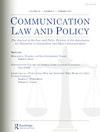托马斯·i·爱默生:《第32条修正案的正面》,15 Georgia L. Rev. 795 (1981)
IF 0.2
Q4 LAW
引用次数: 0
摘要
托马斯·爱默生对理解言论自由的持久贡献之一是他对言论自由体系的强调,正如他那本著名的书的标题所示。言论自由需要广泛的分析,既要关注言论的支持,也要关注言论的限制;这种自由包括实践、原则和制度以及权利;法律学术应该关注的是言语的结构。这一点经常被承认——学术上引用爱默生的言论自由体系是很常见的——但爱默生方法的积极或肯定的方面并不总是被提出。(文献中使用了许多术语来描述自由的这些方面;在这里,我使用了“肯定的”和“肯定的”,这是爱默生之后的说法,而“肯定的”在相关学科中都很流行。)虽然积极的一面在他的大部分作品中都很明显,但它们都集中在《第一修正案的积极一面》中。这篇文章现在显得有些尖锐,至少有两个原因。首先,它对美国宪法的发展和更好地支持公共言论制度表现出信心。虽然爱默生承认美国的平权主义还相对不成熟,但他认为法院正朝着澄清和加强它的方向发展:“法院走在一条单行道上:在他们愿意采取行动的程度上,结果只能是言论自由体系的扩张,而不是限制。”在许多方面,美国法院从那时起就没有采取行动,即使公共言论发生的环境发生了变化,这种发展(尚未)实现。二、文章本文章由计算机程序翻译,如有差异,请以英文原文为准。
Emerson, Thomas I. The Affirmative Side of the First 32 Amendment, 15 Georgia L. Rev. 795 (1981)
One of Thomas Emerson’s lasting contributions to understanding free speech is his emphasis on the system of freedom of expression, as his well-known book is titled. Free speech needs broad analysis that pays attention to supports for, as well as limitations of, speech; the freedom encompasses practices, principles and institutions as well as rights; and it is the structures underlying speech that should concern legal scholarship. The point is frequently recognized — scholarly references to a system of free speech following Emerson are common — but the positive or affirmative dimensions of Emerson’s approach are not always brought out. (The literature uses many terms for these aspects of the freedom; here I use both “affirmative,” after Emerson, and “positive,” which has currency across relevant disciplines.) While positive dimensions are evident in much of his work, they are encapsulated in “The Affirmative Side of the First Amendment.” The article is now somewhat poignant, for at least two reasons. The first is the confidence it displays in U.S. constitutional law developing and better supporting the system of public speech. While Emerson recognizes that U.S. affirmative doctrine is relatively inchoate, he sees the courts as moving toward clarifying and strengthening it: “[T]he courts are on a one-way road: to the extent that they are willing to act, the result can only be an expansion, not a restriction, of the system of freedom of expression.” In many ways, U.S. courts have not acted since then and such development has not (yet) come to pass, even as the environment in which public speech occurs has transformed. Second, the article
求助全文
通过发布文献求助,成功后即可免费获取论文全文。
去求助
来源期刊
CiteScore
0.60
自引率
33.30%
发文量
7
期刊介绍:
The societal, cultural, economic and political dimensions of communication, including the freedoms of speech and press, are undergoing dramatic global changes. The convergence of the mass media, telecommunications, and computers has raised important questions reflected in analyses of modern communication law, policy, and regulation. Serving as a forum for discussions of these continuing and emerging questions, Communication Law and Policy considers traditional and contemporary problems of freedom of expression and dissemination, including theoretical, conceptual and methodological issues inherent in the special conditions presented by new media and information technologies.

 求助内容:
求助内容: 应助结果提醒方式:
应助结果提醒方式:


